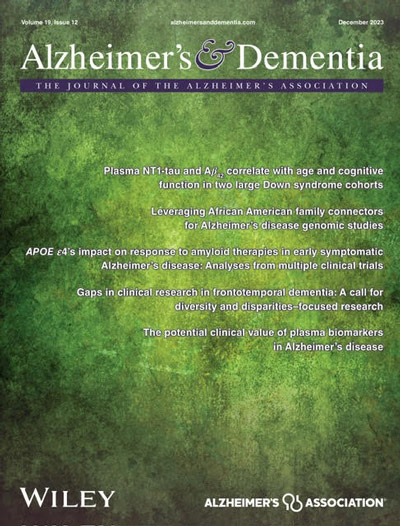The plasma miRNAome in ADNI: Signatures to aid the detection of at-risk individuals.
IF 13
1区 医学
Q1 CLINICAL NEUROLOGY
引用次数: 0
Abstract
INTRODUCTION MicroRNAs are short non-coding RNAs that control proteostasis at the systems level and are emerging as potential prognostic and diagnostic biomarkers for Alzheimer's disease (AD). METHODS We performed small RNA sequencing on plasma samples from 847 Alzheimer's Disease Neuroimaging Initiative (ADNI) participants. RESULTS We identified microRNA signatures that correlate with AD diagnoses and help predict the conversion from mild cognitive impairment (MCI) to AD. DISCUSSION Our data demonstrate that plasma microRNA signatures can be used to not only diagnose MCI, but also, critically, predict the conversion from MCI to AD. Moreover, combined with neuropsychological testing, plasma microRNAome evaluation helps predict MCI to AD conversion. These findings are of considerable public interest because they provide a path toward reducing indiscriminate utilization of costly and invasive testing by defining the at-risk segment of the aging population. HIGHLIGHTS We provide the first analysis of the plasma microRNAome for the ADNI study. The levels of several microRNAs can be used as biomarkers for the prediction of conversion from MCI to AD. Adding the evaluation of plasma microRNA levels to neuropsychological testing in a clinical setting increases the accuracy of MCI to AD conversion prediction.引言微RNA是在系统水平上控制蛋白稳态的短非编码RNA,正在成为阿尔茨海默病(AD)的潜在预后和诊断生物标志物。方法我们对847名阿尔茨海默病神经影像倡议(ADNI)参与者的血浆样本进行了小RNA测序。讨论我们的数据表明,血浆微RNA特征不仅可用于诊断MCI,关键是还可用于预测MCI向AD的转化。此外,结合神经心理学测试,血浆 microRNA 组评估有助于预测 MCI 向 AD 的转化。这些发现引起了公众的极大兴趣,因为它们通过确定老龄人口中的高危人群,为减少滥用昂贵的侵入性检测提供了一条途径。几种微RNA的水平可用作预测从MCI转变为AD的生物标志物。在临床环境中,将血浆微RNA水平评估加入神经心理测试可提高MCI向AD转化预测的准确性。
本文章由计算机程序翻译,如有差异,请以英文原文为准。
求助全文
约1分钟内获得全文
求助全文
来源期刊

Alzheimer's & Dementia
医学-临床神经学
CiteScore
14.50
自引率
5.00%
发文量
299
审稿时长
3 months
期刊介绍:
Alzheimer's & Dementia is a peer-reviewed journal that aims to bridge knowledge gaps in dementia research by covering the entire spectrum, from basic science to clinical trials to social and behavioral investigations. It provides a platform for rapid communication of new findings and ideas, optimal translation of research into practical applications, increasing knowledge across diverse disciplines for early detection, diagnosis, and intervention, and identifying promising new research directions. In July 2008, Alzheimer's & Dementia was accepted for indexing by MEDLINE, recognizing its scientific merit and contribution to Alzheimer's research.
文献相关原料
| 公司名称 | 产品信息 | 采购帮参考价格 |
|---|
 求助内容:
求助内容: 应助结果提醒方式:
应助结果提醒方式:


